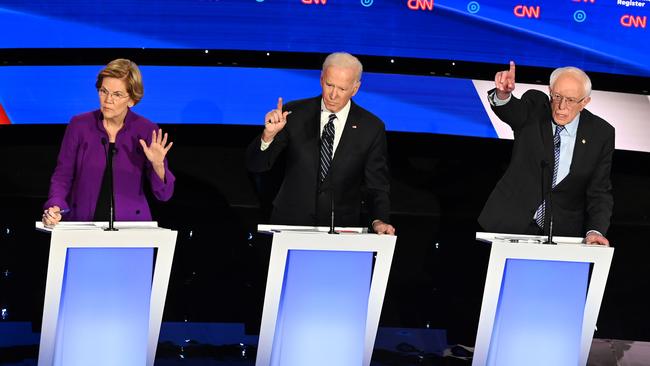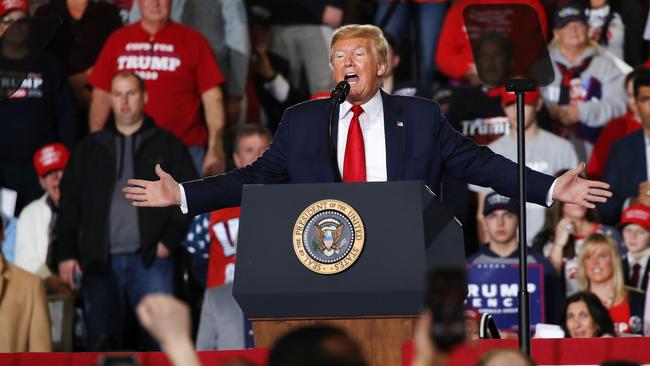Donald Trump puts America’s money where his mouth is
Despite the smoke and fire rising from the US Senate, one number demonstrates just how hard Donald Trump will be to beat.

Amid the drama of the impeachment trial and on the eve of the first primary contest for potential Democratic presidential rivals, there was a poll that underlined just how difficult Donald Trump will be to defeat in this year’s election.
The latest Washington Post-ABC News Poll reveals big-picture trends are favouring Trump in a way that are likely to be far more consequential than the partisan passions consuming Washington.
The findings of the poll were largely drowned out by the wall-to-wall impeachment coverage but they highlight the challenge for Democrats to defeat an incumbent president when the economy is humming.
It found there is rising approval for Trump’s handling of the economy and a drop in the number of people worried about maintaining their standard of living.
Fifty-six per cent of respondents approve of the way Trump is handling the economy, up sharply from 46 per cent last May and the highest of his presidency, while those who disapprove of his economic stewardship dropped to 37 per cent, easily the lowest of his term in office.
The poll also found only 43 per cent are more worried about maintaining their standard of living compared with 63 per cent in early 2016 while 56 per cent are less worried, up from 37 per cent.
It is this rising satisfaction with economic circumstance, rather than any Republican voter backlash against impeachment, that is most likely driving a modest rise in Trump’s approval rating, which the poll said was 44 per cent, the equal highest of his presidency, while his disapproval rating fell to 51 per cent, the lowest since Trump entered the White House.
In Iowa, where the first Democratic presidential caucus is being held on Tuesday (AEDT), the crowded field of Democratic hopefuls has campaigned on the message that Trump’s economy has only increased the gap between rich and poor.
“When you see a government that works great for those with money and it’s not working so well for everyone else, that is corruption, pure and simple, and we need to call it out for what it is,” Elizabeth Warren tells voters on her stump speech in Iowa.
Each of the 12 Democratic candidates to varying degrees hammers the message that America is increasingly a nation of haves and have-nots. They are backed by the US Census Bureau, which reported in September last year that income inequality in the country had reached its highest level in 50 years.
But Republicans cite the old saying that a rising tide lifts all boats, and the fact unemployment is at a 50-year low, inflation is tamed and wages have grown is at least a part of the reason behind Trump’s improved approval ratings.

Economic growth has slowed to about 2 per cent, short of Trump’s goal of 3 per cent. But he argues that the continuous economic growth under his watch has helped the struggling rust-belt towns of the midwest, where Trump won the votes of his so-called forgotten people in 2016.
At his campaign rallies, the President puts the economy front and centre of his pitch for re-election, describing it as “terrific” and “the greatest in the history of the country”.
At the recent World Economic Forum in Davos, Switzerland, he said it was an “unprecedented comeback” for an economy that was in a “dismal state” when he took over the White House.
This is Trump salesmanship — the US economy was not in a dismal state when he took office in 2016. Trump, like Bill Clinton in the 1990s, was lucky to inherit an economy on the upswing but, to his credit, he has made the most of it.
Barack Obama inherited arguably the worst economic crisis since the Depression when he was elected in 2008, but by the time he left in 2016 unemployment had been falling for six years and the US was in its seventh straight year of economic growth.
What Trump has done is pour fuel on that fire with his tax-cut stimulus of 2017 and by sweeping away regulations, including environmental, that he saw as being anti-business. The result: under Trump wages have grown at a much higher level than they did under Obama.
The buoyant economy has given Trump the ability to wield a big stick in his trade war with China in a way that he could not afford to do if economic growth were anaemic and a recession loomed.
Although many economists blame the tit-for-tat tariff trade war with Beijing for the slowdown in growth from almost 3 per cent to about 2 per cent, the apocalyptic fears that it might tip the US into recession no longer appear likely, at least not before the election in November.
Trump has been able to turn trade from a potential weakness into one of his trump cards for this election year.
In key swing states such as Wisconsin, Pennsylvania and Michigan, the loyalty of farmers, one of the most reliably Republican-voting blocs, was being sorely tested by the trade war as demand and prices for products such as soybeans all but collapsed.
Trump doled out a whopping $US28bn in farm aid, but in many cases it did not make up for the losses.
But Trump’s “phase one” trade deal with China last month is likely to quell any voter revolt against the President from his rural constituency.
Under the deal, China has pledged to buy an extra $US200bn ($297.5bn) worth of US goods across the next two years including $US32bn of agricultural goods, more than it purchased before the trade war began.
Trump enjoyed another win on trade this week with the formal signing into law of the revamped deal that was formerly known as the North American Free Trade Agreement and now rebranded as the US-Mexico-Canada Agreement. At a White House ceremony to mark the signing, Trump touted the deal as a “colossal victory … for American workers” that would “make our blue-collar boom even bigger” and “keep jobs in America”.
In yet another remarkable “split-screen moment”, as Trump was touting the benefits of the new USMCA, a few kilometres away the US Senate was holding his impeachment trial.
On impeachment, the Washington Post-ABC poll shows voters are still evenly divided, with 47 per cent believing the Senate should vote to remove the President from office while 49 per cent oppose such a move.
This is a harsher verdict on Trump than voters rendered on Clinton during his impeachment trial when the same poll found only 33 per cent of voters wanted Clinton removed from office while 66 per cent did not.
With Trump, most voters — 59 per cent — say they disapprove of the way he is handling the impeachment saga, with only 39 per cent approving his response to it.
More voters say they think that if the Republican-controlled Senate acquits Trump — which appears almost certain after the Democrats on Friday lost a Senate vote to call new witnesses — it would be a victory for Trump rather than Democrats, even though he already has been impeached by the House of Representatives. The poll finds only 10 per cent of voters think this outcome will be seen as a victory for Democrats, while 33 per cent say it will be a win for Trump with a little more than half — 55 per cent — saying it would be a “split decision”.
This is why Democratic hopefuls on the campaign trail in Iowa are giving relatively little time in their stump speeches to impeachment and instead are focusing on real-life issues of healthcare, jobs and inequality.
During the past three months, the hypothetical match-ups between Trump and each of the leading Democratic candidates have narrowed to become close match-ups.
Whereas three months ago, each leading Democrat — Joe Biden, Bernie Sanders, Elizabeth Warren and Pete Buttigieg — held double-digit advantages over Trump with registered voters, each Democrat is now almost neck and neck with Trump and are within the Washington Post-ABC poll’s four-point margin of error.
This can change quickly and whichever candidate emerges from the closely fought Iowa caucus can expect to get a major boost in the polls as Americans focus on them as a potential Democratic nominee.
The RealClear Politics average of polls shows Sanders (23.8 per cent) and Biden (20.2 per cent) have emerged as favourites to win Iowa, followed by Buttigieg on 15.8 per cent, Warren on 14.6 per cent and Amy Klobuchar on 9.6 per cent.
The emergence of the left-wing Sanders and the moderate Biden suggests the Democrats are still unreconciled about the sort of candidate they believe can defeat Trump in the coming election.
The President reportedly prefers Sanders as an opponent because he can more easily portray Sanders’s liberal agenda as that of a “radical socialist”.
The latest polls show that a clear margin of 38 per cent of voters believe former vice-president Biden has the best chance of defeating Trump, followed by 18 per cent for Sanders, 10 per cent for Warren and 8 per cent for former New York mayor Michael Bloomberg, who is not contesting the early caucus states.
But even so, with a little more than nine months until election day, more voters believe Trump will win a second term (49 per cent) than do not (43 per cent).
Despite the smoke and fire rising from the US Senate, the controversy over impeachment is unlikely to resonate with voters as much as big-picture issues such as the economy, jobs, healthcare and immigration.
These are the issues that will form the battleground of this coming campaign, not the rights and wrongs of presidential interference over aid to Ukraine.
Cameron Stewart is also US contributor for Sky News Australia.




To join the conversation, please log in. Don't have an account? Register
Join the conversation, you are commenting as Logout